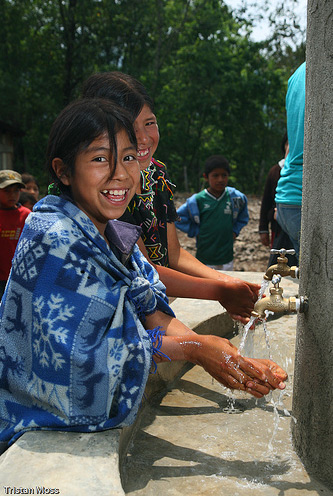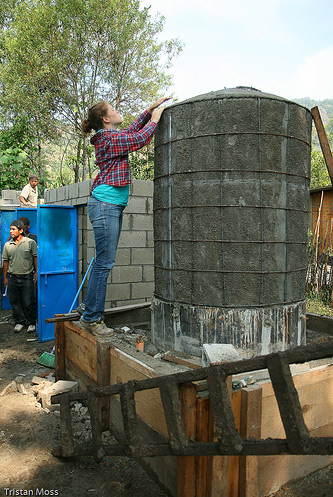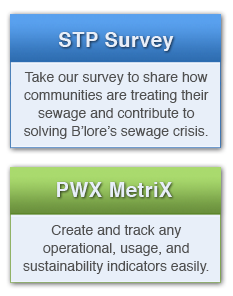Quotes
from members, experts, and process innovators.
Photographers Visit Gautemala to Launch Photophilanthropy’s Partnership with PWX
April 22, 2010Nebaj, Guatemala
Peer Water Exchange (PWX) has teamed up with PhotoPhilanthropy, an online community of photographers volunteering their time and skills with various non-profit organizations around the globe. In an inaugural event, PhotoPhilanthropy volunteers Jodi and Tristan Moss visited several projects by PWX’s Guatemalan partner, Agua Para La Salud.
 PWX, a project of the Blue Planet Network Foundation, is an interactive network of water and sanitation organizations working in over 20 countries and hosting the largest open repository of water projects. PWX members collaborate from the grant application to long-term assessment to divide the problem of managing thousands of small-scale projects into manageable chunks.
PWX, a project of the Blue Planet Network Foundation, is an interactive network of water and sanitation organizations working in over 20 countries and hosting the largest open repository of water projects. PWX members collaborate from the grant application to long-term assessment to divide the problem of managing thousands of small-scale projects into manageable chunks.
PhotoPhilanthropy links photographers of all skill levels and backgrounds to non-profit organizations working toward social change in various sectors and geographic locations. Inspiring photographers to use their creativity, PhotoPhilanthropy focuses on capturing not only social issues, but also on photographing the problem-solving work being done by non-profit organizations.
Since PWX shares all project data on a publicly accessible interactive map, inviting the world to help assess the real progress against the global water crisis, there was a natural fit with PhotoPhilanthropy. Nancy Farese, the founder of PhotoPhilanthropy, observes: “PhotoPhilanthropy is dedicated to supporting these kinds of dynamic partnerships between talented photographers and effective nonprofits. We are thrilled to know that we helped introduce Jodi and Tristan to Blue Planet Run and the Peer Water Exchange, and we are amazed to see the results of their collaboration!”

PWX’s partner, Agua Para La Salud, who has been executing water systems in Guatemala for 16 years, organized the entire trip for the photographers. Lynn Roberts, ED of APLS, “We were excited and honored to host these wonderful photographers whose beautiful pictures will showcase the transformed lives of our communities.” Jodi Moss states, “PWX provided us with unparalleled exposure to water conditions in rural Guatemalan villages. Working directly with experienced locals, we learned first hand the positive impact that well-managed and properly allocated funding can make. We are excited to share what we learned with others through our photos and our stories.”
PhotoPhilanthropy volunteers will provide even further increased exposure and visitation to any of the hundreds of PWX projects worldwide, in turn providing a third-party layer of project reporting toward increased long-term sustainability. At www.peerwater.org, PhotoPhilanthropy volunteers can find projects in locations of interest. After visiting projects, volunteers simply upload their notes to their project on the website attaching powerful field photos, adding visual and narrative context to the project’s ongoing and transparent story.
“Small-scale projects tailored to the needs of the locals and eventually owned and adopted by the community are the key to solving the water crisis.” said PWX architect, Rajesh Shah. “Due to the need for change in behavior and ownership, these projects in reality only begin after the ribbon-cutting ceremony. So more eyes viewing the work and sharing the information gives us extremely vital insight into the functioning and evolution of the project years after ‘completion’, continues Rajesh. “The decentralized collaborative network model of PWX will help solve the world’s water crisis and we are extremely grateful to PhotoPhilanthropy volunteers who beautifully document share the good work and results happening in remote places with the world.”
For more information, please visit the following links:

How PWX Can Help You
PWX Snapshot
- Communities Assisted: 3267
- Number of Countries: 42
- People Benefited: ~ 1,524,810
- Programs/Projects: 2112 ($52M)
- Projects in Progress: 140
- STPs Tracked (map): 65 (list)
- Community Contribution: 8.9%
- Plans Peer Reviewed: 249 ($11M)
- Peer-Approved Plans - Needing Funds: 26
News Highlights
- Farewell Jin Zidell - A Monumental Figure In Water Jun 16, 2023
- Rain Centre Monitors Chennai's Water Table Mar 18, 2018
- Picture (of) 10 years of connecting WASH people Mar 16, 2016
- Let The Children Lead Bangalore Out Of Its Sewage Mess Feb 26, 2016
- Stopping Sewage from entering Lakes at Kaikondarahalli Kere Habba Jan 09, 2016
Get Involved
- Join PWX and use it to manage your water investment portfolio or make your project history come alive.
- Donate and maximize the impact of your contribution using PWX's peer-review and long-term impact assessment processes.
- Volunteer as a citizen journalist and help verify our progress against the water crisis!
Team
- The team behind PWX
- An interactive logo collage and list combo of the network
- An interactive list of our 136 members.
Contact
© 2006-2020 Peer Water Exchange
